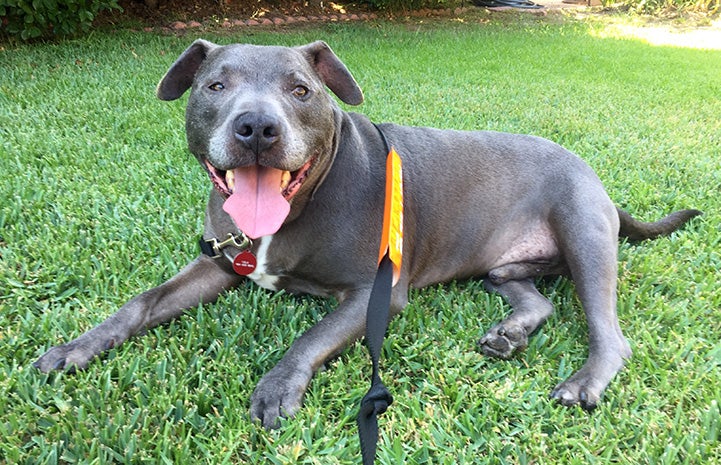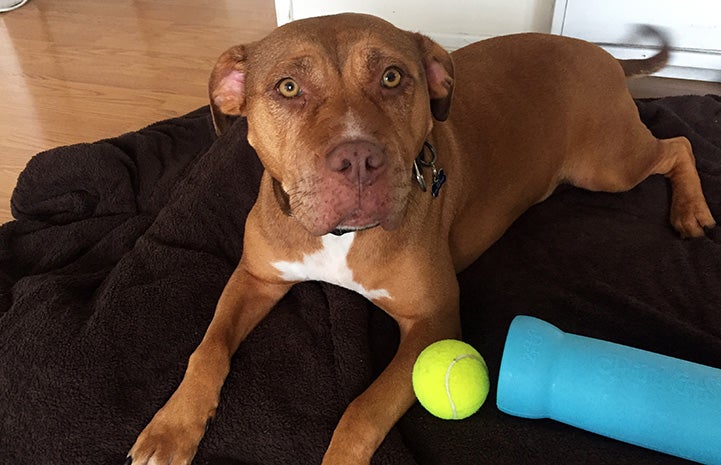If you want to help a shelter dog, take one home for a sleepover

Marie Curie, a gray pit bull terrier mix with yellow eyes, hooked me on our first walk. She was easy on the leash and her sweet nature was unavoidably endearing. It was inevitable that our relationship would quickly lead to the next step — sleeping together.
While the idea of a doggy sleepover sounded like fun, it was also an emotional hurdle for me to cross. I had intentionally not allowed another dog into my home since Gracie, my beloved chocolate Lab, passed away one year earlier. It was still her space. But Marie Curie needed in-home notes for her kennel door, and I knew how important that was to her future success.
So, I collected all the items that the Best Friends provides for our overnight stay: blanket, towel, feeding dishes, food, toys, leash, doggie bags and, of course, the prized evaluation sheet. I hoped Marie Curie would do well, but I couldn’t be certain. Would she potty inside, tear my furniture apart, chew up my shoes or jump on the counters? Despite my initial concerns, I packed up Marie Curie along with the borrowed items, and we were homeward bound.
About Best Friends in Los Angeles
How sleepovers help shelter dogs get adopted
The Slumber Buddies program is a fantastic opportunity for dogs to get out of their kennels and gain experience in a home. A sleepover not only reduces stress by removing the dog from the shelter environment and allows them to decompress. It also gets them comfortable with the routines of a home, some of them for the first time.
The program also makes it possible for volunteers to gather valuable insight into how dogs are in a home. Volunteers take notes on how the dog adjusts to the new place, including the most interesting room of all — the kitchen — where tempting smells abound and treats are often stored. Introducing the dog to common noises in the home (TV, electric toothbrushes, blenders, and neighbors) gives clues as to whether the dog already has in-home manners or went through obedience training. All this information helps a potential adopter get a better idea of how the dog will behave in their own home. Dogs with in-home notes tend to get adopted faster, because people feel more confident in the personality of the dog they are considering.
Miriam Giordano, lifesaving manager at the NKLA Pet Adoption Center, has witnessed the impact of the Sleepover Buddies program. “The in-home notes that our volunteers have gathered as part of this program have dramatically improved our ability to help match families with their new pets,” says Miriam. “The notes give us an insight into how the dog will initially behave in a new home, which then also allows us to better advise families how to successfully introduce a new dog into their home.”
Dog sleepover leads to adoption
 Marie Curie climbed the outdoor, open stairs to my one-bedroom apartment without hesitation and once inside, conducted a thorough investigation of each room before eagerly looking at me for direction. After dinner, I realized that her agenda (which consisted of snuggling, belly rubbing and toy chewing with Season Three of “GLOW” on in the background) would take precedence this night.
Marie Curie climbed the outdoor, open stairs to my one-bedroom apartment without hesitation and once inside, conducted a thorough investigation of each room before eagerly looking at me for direction. After dinner, I realized that her agenda (which consisted of snuggling, belly rubbing and toy chewing with Season Three of “GLOW” on in the background) would take precedence this night.
I had deeply missed Gracie’s companionship, and now I was able to enjoy Marie Curie’s presence and, at the same time, serve a purpose. Not an hour had passed before she was struggling to stay awake. She seemed content to turn in early and capitalize on a peaceful atmosphere that was absent of barking dogs or people passing by and peering into her kennel before moving on. She was free to relax.
This was her first sleepover too, and she made every effort to communicate her appreciation with loving looks and nudges, along with showing some exceptional behavior. After she understood we would not be sleeping in the same bed, she made herself comfortable on her own bed next to mine, and then proceeded to snore through the dark hours, not waking until dawn.
The next morning included a romp through a nearby park and a visit to Petco to peruse the enticing toy and treat aisles, before returning to the NKLA Pet Adoption Center at noon when it opened to the public. I gave Marie Curie outstanding comments from her sleepover (polite, obedient and loving). She had clearly lived in a home before, something that would surely encourage her prospective adopter. I was so pleased with her behavior and enjoyed her company so much that I invited her back the following night to provide her with more time for decompression.
Returning her the second morning was harder than the first. Attachment grows fast. The good news is that the day after my notes were posted to her kennel door, Marie Curie was adopted. I was thrilled, because my feedback had directly influenced an adopter’s decision.
So many dogs, so many sleepovers
A successful and pleasant experience with Marie Curie helped me overcome my resistance to another dog in Gracie’s space. So, over the next several weekends I separately took home four dogs who either needed in-home notes or had developed a relationship with me through nightly walks after work.
These included Dumpling, a world class hiker and gentle pit bull terrier mix who was desperate for love (displayed by his constant need for nuzzling). Ferrero was a mature shepherd mix who enjoyed sitting at the baby gate in the doorway to take in the fresh air and outdoor views, eventually loosening up on his second night to accept more affection.
Then there was Marlin, a sturdy, silver pit bull terrier mix who happily announces his presence by barking throughout his walk at the center. But he never made a sound at home. Instead, he took every opportunity to lie on his back for chest and belly rubs.

Most recently, I brought home caramel-colored Stella, a skittish but affectionate and well-mannered pit bull mix.
A dog’s fun day
Each dog had a unique approach to the stairs leading to my apartment. For instance, Dumpling was scared and needed to be coaxed with treats, but by the second night had overcome his fear. Physically challenged Marlin struggled, and as a result, did not return for a second night. But even that was valuable information for a future adopter because we learned that he’d do best in a home without a lot of stairs.
While most sleepover evenings are similar in activity (a McDonald’s plain hamburger added to the standard kibble dinner, lots of affection, ample playtime and a potty break before bed), each dog dictates a morning based on physicality or personality — from hiking to window shopping, to just sitting outside and watching the world go by.
Each of the dogs in their own way communicated happiness and gratitude of being at home with me and out of their kennel. And in their eyes, when I return to the center to take them for a walk, I’m a rock star. We share a bond developed from sharing intimate time and space.

Sleepover successes
Beyond the fun came measurable results: In addition to Marie Curie, Dumpling and Ferrero being adopted soon after our sleepovers, Marlin and Stella have gone into foster homes. I’ve had enjoyable experiences with five different dogs, resulting in complimentary notes for all.
It’s not only fun but also rewarding to know that I’m giving the dogs the gift of a much-needed break, and at the same time informing potential adopters of the dogs’ true personalities that tend to emerge only outside of the shelter environment. It’s a win-win and I am grateful to participate in a lifesaving program that helps dogs find their forever homes faster. One takeaway has been that with every sleepover, you get back much more than you give.
Help save a life by fostering a pet near you
Photos courtesy of Tara McKenney